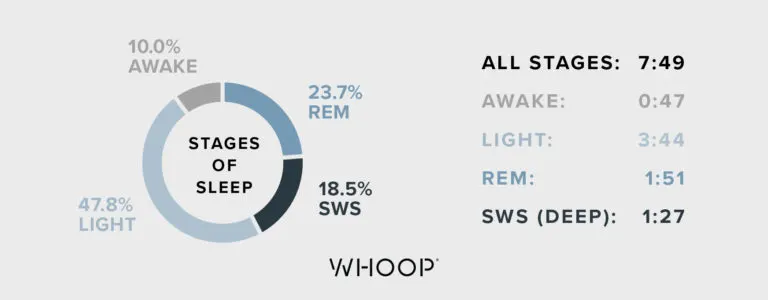Topics
- Article
- Sleep
What is Light Sleep and Why It’s Important

Light sleep is as important as the other stages of sleep, although it gets less attention. Learn what happens during light sleep and why it’s an integral part of the sleep cycle.
Light sleep is the transitional stage between waking and sleeping. Your body goes through 4 sleep stages during the night, cycling through these stages several times while you’re asleep.
What Happens During Light Sleep?
As you begin falling asleep, your heart rate and respiratory rate slow. At this stage you may still hear noise and be sensitive to temperature changes and movement, and you may believe you’re still awake. You may begin dreaming during light sleep, but your dreams will likely be less coherent or intense than dreams during REM sleep. It’s far easier to wake during light sleep than other stages.
How Much Light Sleep Do You Need?
In your first sleep cycle light sleep often lasts between 10-30 minutes, and it gets longer during subsequent cycles. On average you’ll go through 3-5 sleep cycles each night and 40-50% of that consists of light sleep. The average for WHOOP members is between 3.5 and 4 hours of light sleep per night.

Light sleep comprises 47.8% of the average WHOOP member's nightly sleep.
As we age, we tend to get more light sleep and less deep sleep, losing about 10-12 minutes per decade of age as our bodies produce lower levels of growth hormone and melatonin. Total sleep time can decrease and we may wake more often because we get less deep sleep.
How Important is Light Sleep?
Every stage of sleep is important for physical and mental health. While emphasis is often placed on deep sleep and REM sleep, we cannot overlook the importance of light sleep. Although light sleep doesn’t sound restful, that’s not the case. It is the point where your muscles relax, your body temperature decreases, and your brain waves begin slowing. As brain activity slows during light sleep we experience short bursts of activity that help us resist being woken up by external stimuli. Light sleep suppresses our senses and prevents us from moving so we can remain asleep. It’s also important for memory, learning and motor skills. Getting sufficient light sleep is essential to meeting your overall sleep needs. Chronic sleep deprivation is associated with high blood pressure and heart disease, as well as obesity, depression and problems with your immune system. Without adequate sleep we may find ourselves unable to process new information or learn new skills and we lose the ability to access previously learned information. We can also suffer from poor judgement and lose the ability to assess situations, plan and choose behaviors.
WHOOP Tracks All Stages of Sleep
WHOOP tracks your sleep each night and tells you exactly how much time you spend in each stage of sleep. The Sleep Planner uses your circadian rhythm to help you establish a nightly routine by determining the best time for you to go to bed and wake feeling refreshed. WHOOP 4.0 also features gentle haptic vibrations to wake you at the exact time you want to get up, or when you’ve met your sleep or recovery goals.

WHOOP Sleep Metrics display how much sleep you get each night, to help you learn about your sleep habits.
Light Sleep FAQs
How much light sleep is normal?
The amount of light sleep considered normal varies depending on individual factors such as age, sex, and overall health. Generally, adults spend around 50% of their total sleep time in light sleep stages, while the other 50% is split between deep sleep and REM sleep. However, an individual's sleep pattern can vary from night to night, and factors such as stress, illness, or medication use can affect the amount of time spent in each sleep stage.
Is light sleep good sleep?
While light sleep stages are important for the initial stages of sleep and can help the body relax and recharge, a healthy sleep pattern requires adequate amounts of all sleep stages, including deep sleep and REM sleep. Light sleep is necessary for the overall quality and duration of sleep, but prolonged or disrupted light sleep may affect sleep quality and lead to issues such as daytime sleepiness or fatigue.
Is light sleep better than deep sleep?
No, light sleep is not necessarily better than deep sleep. Both light and deep sleep stages are important for different aspects of physical and mental restoration and function during sleep. A healthy sleep pattern requires adequate amounts of both light and deep sleep, as well as REM sleep. The amount of light sleep considered normal varies depending on individual factors such as age, sex, and overall health. Generally, adults spend around 50% of their total sleep time in light sleep stages, while the other 50% is split between deep sleep and REM sleep. However, an individual's sleep pattern can vary from night to night, and factors such as stress, illness, or medication use can affect the amount of time spent in each sleep stage.
While light sleep stages are important for the initial stages of sleep and can help the body relax and recharge, a healthy sleep pattern requires adequate amounts of all sleep stages, including deep sleep and REM sleep. Light sleep is necessary for the overall quality and duration of sleep, but prolonged or disrupted light sleep may affect sleep quality and lead to issues such as daytime sleepiness or fatigue. A healthy sleep pattern requires adequate amounts of both light and deep sleep, as well as REM sleep.